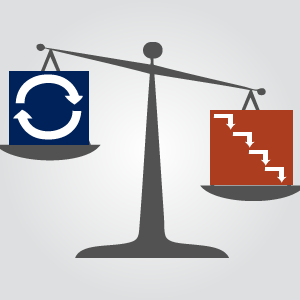How to Decide What Projects are Suitable for Agile vs. Waterfall
Advocates of Agile are known to imply or outright state that Agile works best, hands down.
Just as often, opponents will counter with any number of reasons – both legitimate and outrageous – why classic, plan-driven project management methodologies (like the waterfall method in software development) are the better choice.
The fact is, they’re both right.
In a fascinating “mathematical analysis” comparing several popular Agile frameworks with waterfall project management in a real-world project setting, Kevin Thompson, Ph.D, provides statistical evidence to support the validity of both options and to help you understand which to choose for your project.
His paper is titled, “How Agile Should Your Project Be?” Here is a brief synopsis:
Begin With What You Know
To decide whether the project your team is tasked with completing should be handled using an Agile framework or classic plan-driven method, take a look at the information you already have.
• Are requirements for the finished project complete, clear and stable?
• Can the effort required to complete the project be easily predicted?
• Have you successfully completed previous projects similar to the one you’re about to start?
If you can answer “yes” to these questions, then a plan-driven process like the waterfall method is likely your best bet.
Why?
Because answering “yes” to these questions indicates the project you’re about to start is predictable to a reasonable degree. You’ve likely done one or more projects very similar to it in the past and can rely on the outcome being roughly the same this time.
That kind of reliability and stability makes achieving an adequate ROI (return-on-investment) simple: We can spend $x because we know it will cost us $y to complete the project and we will then earn $z upon completion.
However, if you must answer “no” to any of these questions, the level of predictability drops and adequate ROI becomes a risk.
Determine How to Mitigate the Risk
Once the level of predictability goes down, statistics show that it’s smarter to use an Agile framework to initiate the project and achieve ROI through successful iterations. Several frameworks exist in the Agile world so make sure to ask the right questions to help decide which way to start. For example:
•Is it necessary to plan the project at all?
•Is it possible to plan the project?
If the answer to these questions is no, Kanban is your best bet. It automatically assumes planning is unnecessary and/or impossible due to the nature of the project and therefore jumps right into deployment in an organized way.
•Can tested deliverables be completed in short cycles?
If they can, Scrum will likely be the best framework to implement. If not, CBPM is the most viable alternative.
Remember, every project has a different definition of “success.” We find that that the Agile project provides clear benefits for return-on-investment and risk reduction, compared to the plan-driven project, when uncertainty is high. When uncertainty is low, plan-driven projects are more cost-effective.
To gain a more granular review of your particular situation and criteria to consider for choosing the most effective process, sign up for one an Agile Strategy Session.



